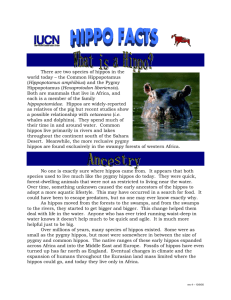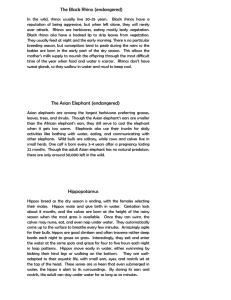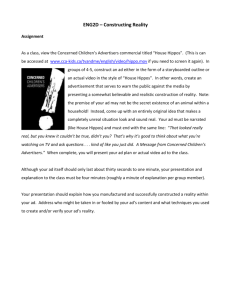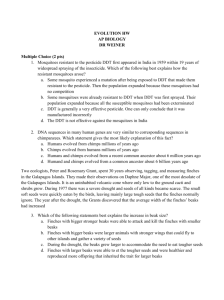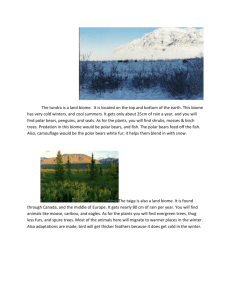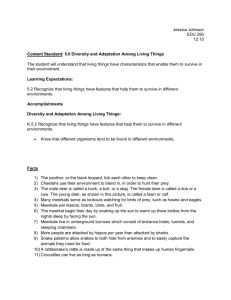Distribution of hippos in Mono Basin
advertisement
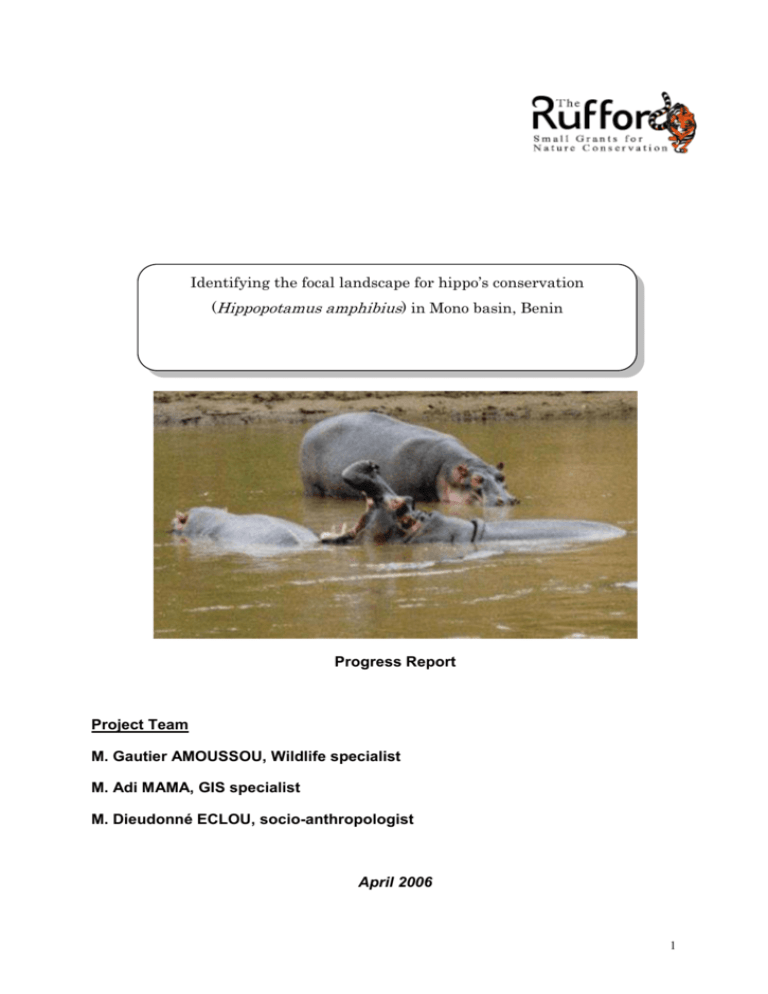
Identifying the focal landscape for hippo’s conservation (Hippopotamus amphibius) in Mono basin, Benin Progress Report Project Team M. Gautier AMOUSSOU, Wildlife specialist M. Adi MAMA, GIS specialist M. Dieudonné ECLOU, socio-anthropologist April 2006 1 CONTENTS 1. INTRODUCTION .................................................................................................... 3 2. MATERIALS & METHODS ..................................................................................... 3 3. IDENTIFICATION OF HIPPOS BIOLOGICAL LANDSCAPE IN MONO BASIN ..... 4 3.1. Occurrence of hippos in communes of Aplahoué and Djakotomey .................. 4 3.2. Occurrence of hippos in communes of Dogbo and Lokossa ............................. 5 3.3. Occurrence of hippos in communes of Athiémé and Grand-Popo .................... 6 3.5.1. Flora composition ....................................................................................... 9 3.5.2. Fauna composition ................................................................................... 11 4. IDENTIFICATION OF HUMAN LANDSCAPE ...................................................... 11 4.1. Landscape utilization for human activities ...................................................... 11 4.2. Hippos’ impact on human landscape activities ............................................... 13 5. DISCUSSION OF RESULTS ................................................................................ 15 5.1. Dynamic of hippos groups in the basin ........................................................... 15 5.2. Dynamic of habitats using by hippos in Mono basin ....................................... 16 6. DETERMINATION OF THE FOCAL LANDSCAPE FOR HIPPOS CONSERVATION ..................................................................................................... 18 7. CONCLUSION ...................................................................................................... 18 2 1. INTRODUCTION In Benin republic, the hippo population in Mono River Basin is split into small, isolated groups from single to one hundred individuals. These small populations are vulnerable to catastrophes, such as drought or a surge in poaching, as well as to genetic problems resulting from risk of inbreeding so that the current prospects for their long-term survival must give cause for concern. Habitat loss has been identified as the factor that most threatens hippos survival. Farmers increasingly transform the natural landscape by clearing wetlands habitat for agriculture. Hippos, while tolerant of human disturbance to some degree, are unable to survive when the natural habitat becomes dominated by farmland and fisheries. It is actually imperative that hippo’s habitat requirements are understood and identified, so that land and wetlands can be managed both for conservation and human activities (agriculture and fisheries). This project aim is then to identify the focal landscape where NGOs and wildlife agencies could emphasize their conservation actions. But to reach this goal, it is necessary at first to master some biological and ecological parameters of the hippopotamus, and also to master deeply the origin of conflicts between hippopotamus and humans. Thus in this respect, this study is being issued since November, 2005 in Benin areas of Mono basin such as communes of Aplahoué, Athiémé, Bopa, Comé, Dogbo, Djakotomey, Grand-Popo et Lokossa. 2. MATERIALS & METHODS The research on hippos was started since November, 2005 in the Mono basin. Areas from which hippos were reported were visited and detailed information were obtained from forestry officers, managers, sugar, and oil palm plantations, hunters, village chiefs and other well-informed persons. Some semi-structured dialogues and interviews based on questionnaire permit to establish relationship between hippopotamus and humans activities. Distributions of the species were also investigated by the major wetlands by boat and foot patrols. The courses of all major water courses were surveyed. A total of 52 localities were investigated, where local village chiefs and hunters were interviewed and foot patrols carried out in search of the easily identifiable spoor and droppings of hippos. Intensive field investigations were also carried out to determine whether the species might have occurred in unknown areas. 3 The habitats of hippos were studied through observations along fixed transects and observations and counts from boat and on foot on the basis of prior detailed overall vegetation and wetlands mapping. The use of mostly indirect methods, including systematic counts of droppings and tracks along arbitrary or pre-established transects, was also done. Legal texts, reports, and other statistics were evaluated to determine the past conservation situation. 3. IDENTIFICATION OF HIPPOS BIOLOGICAL LANDSCAPE IN MONO BASIN The presence of hippos has been noted in the border communes of the Mono River and the inshore lagoon. The concerned communes are, from the north to the south, Aplahoué, Djakotomey, Lokossa, Athiémé and of Grand-Popo. It is in these communes that have been met lakes, pools, ponds, effluents, River and lagoon sheltering hippos seasonally or permanently. The presence of hippos has been marked by their direct observation or detection of footprints, droppings, and tracks. 3.1. Occurrence of hippos in communes of Aplahoué and Djakotomey In the commune of Aplahoué, hippos especially occur in the Mono River in areas with high depth or in areas with forests galleries whose banks are easily accessible. The used area spreads from the district of Djikpamè to Nakidahohoué (Cf. map1). This segment shelters the Djifri pool nourished by the Mono River water in period of raw. The immediate downstream water of Adjarala rapids serves as shelter to hippos in period of low water when the water flow is low (0, 5 m3/s). But this place is avoided in July when the water flow reaches 450 m3/s. In the commune of Djakotomey, hippos are also localized in the River because of the stiffness of banks. Only one pond (Zoko) shelters hippos in the village of Nakidahohoué, district of Kpoba. 4 3.2. Occurrence of hippos in communes of Dogbo and Lokossa In Dogbo commune, it is in the district of Dévé that hippos are localised (Cf. map 2). It still exists in this locality a curtain more important of gallery forest with 5 to 15 meters large where hippos are observed permanently. Banks of this area are easily accessible to hippos which sometimes reach fields directly. There are several tracks of hippo in the area. In the commune of Lokossa, it is especially in lakes, pools, temporary ponds and effluents of the Mono River that we note the presence of hippos. Here, hippos are observed directly in the Doukon Lake and in the Bovi pond (Cf. map 2). Indications of hippos have been noted at the level of fields, flooding plains, and effluents. It is necessary to notice that in the Doukon Lake, hippos are sedentary. Djètoè and Togbadji lakes are sites of irregular migrations of hippos while villages and ponds are only frequented during periods of flooding. 5 3.3. Occurrence of hippos in communes of Athiémé and Grand-Popo In the commune of Athiémé, banks of the River are abrupt and not accessible to hippos. It is only at the level of Dédékpoè and Ahoho villages that there are some sporadic presences of hippos (Cf. map 3). There are in areas of Kotocoli (commune of Grand-Popo) hippo’s tracks of 60 to 100 cm large that lead to seasonal water points created by the shrinking of flooding water. At the level of Grand-Popo lagoon, hippos are observed in Onkouihoué in a dead arm of this lagoon. They live there in all season since 1987. In fact, before this year the dam of Nagbéto was not installed again, there was a seasonal tipping of the sea water in the lagoon that gave back this impassable biotope for hippos. But since 1988, the water flow during low water periods of the Mono River has reached 40 m3/s, the phenomenon is not noticed anymore and the water of the River persists permanently in the lagoon. Currently, the hippos in this area move until the level of Avlo Island by passing at Hêvè and Agonninkanmè villages. They also go up again until the bridge of GrandPopo and bifurcate in the effluent of the River that passes at Ewécondji village and Agbanakin (Togo). 6 3.4. General distribution and abundance of hippos During the survey period, it has been counted fifteen (15) hippos in lakes, pools and ponds. It is necessary to recognize that these data are those got by direct observation. However data got through questionnaire administration on riparian populations indicated eighteen (18) hippos. The abundance of hippos is more important in the lagoon of Grand-Popo and in the Mono River (Map 4). We counted eight (8) hippos in Grand-Popo lagoon and fifty seven (57) in the Mono River (table1). According to local populations, in period of subsidence, hippos retire in the superior part of the River (downstream water of rapids of Adjarala) and in the AthiéméEwécondji segment precisely in the area of Agbanankin (village situated on the Togolese strand of the River). Results of our investigation through questionnaire administration on riparian populations give some relatively elevated numbers. This is due to the length of the 7 Mono River, two third of people investigated estimated the population of hippos to 66 individuals. At Grand-Popo, the population of hippos has been estimated to 10 individuals by people investigated in the riparian villages of the lagoon. Table 1: Abundance of hippos in Mono basin (Benin) Area of hippos distribution Direct observation data Interview data Lakes, pools and ponds 15 18,75 % 18 Lagoon of Grand-Popo 8 10 % 10 Mono River 57 71,25 % 66 Total 80 100 % 94 In conclusion, we found 71,25 % of hippos population in the Mono River, 18,75 % in lakes, pools and ponds and 10 % in the lagoon of Grand-Popo. In general, 80 hippos were observed whereas interviews indicated existence of 94 hippos. Densities of hippos in individus/km2 or in individus/km of river are presented in the table 2. Table 2: Densities of hippos in Mono basin areas Area of hippos distribution Densities in individuals/km2 Densities in individus/km Lakes, pools and ponds (0,9 km2 ) 16,67 - Lagoon of Grand-Popo (15 km2 ) 0,53 - Mono River (100 km Benin side) - 0,57 8 3.5. Characteristics and utilization of hippo habitats Mono Basin The sites with adjacent hippo activity such as river, lagoon, lake, pool and pond in which traces of hippos are discovered are attributed to their habitat. In this way, we are interested mainly in their flora and fauna. Flora has been studied in specific composition term, the frequency of apparition, the recovery, the dominance and the average height. 3.5.1. Flora composition At the level of lakes, pools, ponds and lagoon, we noted herbaceous and often floating aquatic vegetation, as well as of fallows in their flooding plain. The specific composition of the floating aquatic vegetation is summarized in the table 3. In general, herbaceous aquatic vegetation is commonly composed of Leersia hexandra, Echinochloa pyramidalis, Ludwigia repens and Ipomea aquatica. 9 Hippos graze in herbaceous vegetation where we did measures of linear frequency by the method of the point-quadrates. Thus, 250 point-contacts have been noted in the vegetation where the specific composition is 31 species (table 3). The average height of this vegetation is 1, 20 m. Table 3: The specific composition of the aquatic vegetation. Species Leersia hexandra Echinochloa pyramidalis Polygonum salicifolium Ludwigia repens Ipomea aquatica Cyperus difformis Cyperus haspan Cyperus sp. Fuirena umbellata Aeschynomene indica Nymphea lotus Pentodron pentandrus Sphenoclea zeylanica Commelina sp. Commelina erecta Lemna paucicostata Fuirena ciliaris Importance +++ ++ ++ ++ ++ + + + + + + + + + + + + Species Paspalum polystachyum Melochia corchorifolia Typha australis Cyperus distans Scirpus jacobi Mariscus ligularis Cyclosorus striatus Malachra radiata Vigna racemosa Ceratopteris cornuta Ceratophyllum demersum Dolichos scarabeoides Vigna sp. Pistia stratioites Importance + + + + + + + + + + + + + + +++ = very common, ++ = common, + = present These summaries provided the necessary data for the calculation of parameters such as the specific frequency (F.S.), the relative frequency (F.R.) and the contribution of every species (C.S.). The contribution of every species is calculated and analysed. The most elevated value (45 %) is noted for Leersia hexandra. It is followed by Commelina erecta (30 %), Echinochloa pyramidalis (23 %), and Ludwigia repens (10 %). The 9 other species contribute (for the majority) for less than 5 % to the aquatic grazing of hippos. At the Mono River level, the gallery forest that shelters hippos is dominated by Ficus exasperata, Dialium guineense, Cola cordifolia and Pterocarpus santalinoïdes. At the lagoon level, we have a mangrove dominated by Rhyzophora racemosa and Vossia cuspidata. 10 3.5.2. Fauna composition Fish species that we counted in wetlands with hippos are dominated by those of cichlideae, clariideaes and claroteideaes families. We distinguish notably Sarotherodon melanotheron, Hemichromis fasciatus, Tilapia guineensis, Tylapia sp., Clarias ebriensis, Clarias gariepinus, Chrysichtys auratus and Chrysichtys nigrodigitatus. We also note the presence of crocodiles (Crocodylus niloticus), soft water turtles (Kinixys sp.), pythons (Python sebae, Python regius), grass cutter (Tryonomys swinderianus), and several water birds. In gallery forest along the Mono River, buffalos (Syncerus caffer), sitatungas and guib harnessed (Tragelaphus scirptus) have been signalled. 4. IDENTIFICATION OF HUMAN LANDSCAPE 4.1. Landscape utilization for human activities At the flooding plains level, the fallow is burnt in dry period for food crops and vegetables cultivation. It is cultivated as farms and plantations of sugar cane and teak in humid period. The Mono basin landscape occupancy is defined by map 5. It shows a predominance of farms and palm oil plantations in hippo’s habitats or near wetlands frequented by hippos. 11 On water courses, take place fishing activities that intensify at night. The most common fishing materials are the Tohonga, fish’s traps (Montocloé, Awlè, Djohoun) and other techniques which consist to beat water (Tossisso) and to arrow fishes (Tossoé). Careers of gravel exploitation are established on the periphery of wetlands. Tracks for hippo migration are used for farming and the gallery forests along the River are destroyed for the same raison. The generalization of the cotton crop in the basin involved an acceleration of the phenomenon of soil erosion. Labours make themselves to dish and are not accompanied by convenient anti-erosive means. Consequently, phenomena of extortion of the basins soils, including fields, borders of lakes, and crumbling of banks gave back the completely naked soils in some areas (Dévé, Aplahoué). The 90 % of 12 interviewed persons practice agriculture and the 20 % grow vegetables around hippo habitats. In Grand-Popo, all the interviewed people confirmed the advanced level of the blinding in the lagoon. More than 60 % of the interviewed people recognized a high exploitation of hippo’s habitats for human activities. In the same way, more than two third of interviewed people use flora species such as Ipomea aquatica, Andropogon gayanus and Echinochloa pyramidalis as fodders in the feeding of pigs, sheep, grass cutter and other animals whereas these species are well grazed by hippos. 4.2. Hippos’ impact on human landscape activities Damages have intensified on crops since years 1990. They are intense in rainy seasons when hippos disperse themselves in the wetlands of the basin. The shape and the intensity of damages caused to crops are variable according to crops and their age. Types of damages caused to crops Damages caused to crops by hippos result in the stamping with important feeding having some ominous consequences on the agricultural production. Crops on which damages have been recorded are presented in the table 4. Table 4: Crops damaged by hippos Crops Percentage of people having recorded damages Maize (Zea mays) 81,48 Cassava (Manihot utilissima) 62,96 Cotton (Gossypium sp.) 62,5 Nightshade (Solanum sp.) 40,74 Sugar cane (Saccharum officinarum) 29,63 Corchorus olitorius 29,63 Bean (Vigna sp.) 25,93 Peanut (Arachis hypogea) 18,52 Sweet potato (Ipomea batatas) 16,4 Lycopersicum esculentum 14,92 Banana tree (Musa sp.) 7,4 13 The palm oil, taro, tomato, onion and hot pepper are also affected. Damages are more intense in rainy periods (April in November) on food and cash crops. In dry season, the vegetables installed on the outskirts of wetlands are more attacked. Damages to crops also intensify in period of raw (July in October) just when crops have one month thereabouts or are at maturity. Assessment of damages Damages on cassava, cotton and maize have been accessed along the River. Cotton represents the most destroyed crops. It is due to the morphology of these crops because hippos need to browse more cotton feet than of maize and cassava before satisfying themselves. Besides, all parts of the maize and cassava are consumed, that is not the case for cotton for which only the apical part is often browsed. If the maize is mentioned as the most destroyed crop by 90 % of interviewed people, it is because this crop is the basic alimentary diet in the region and populations are more marked by its destruction than the one of others. Besides all this, the output of this crop is also very low (1 tonne/ha). Field data show strong destroying of crops (30 to 70 %) in the first 100 meters of the River. This certainly indicates that this part represents the area of intense activity of hippos where grazing reserve must be restored along the river. Damages on fishing and navigation activities Wetlands frequented by hippos are often submitted to a high exploitation by the riparian populations. The utilization of water by people and hippos led to a situation of competitiveness very marked at the Grand-Popo lagoon and Doukon levels. One third of people interviewed have been pursued at least once by hippos on water while fishing or the navigating. Hippos destroy frequently nets that are put on their passage. Thus, on the Doukon Lake at least one net is destroyed per day and fish’s traps put in the aquatic vegetation are destroyed regularly by hippos during their grazing. In the lagoon of Grand-Popo, damages to fishing materials vary according to their nature. The net of sparrow hawk (sabou) is torn systematically when it envelops hippo’s rubs under water. The nets called Awlè and Tohonga are pushed in silt by hippos as well as traps installed in the floating vegetations. The Afohou, a material of 14 fishhooks, is cut and taken away by hippos. According to users of this material, the skin of the animal resists the penetration of fishhooks which are sometimes discerned on some hippo bodies. Some fishers would have abandoned the fishing because of the repetition of these incidents and others avoid the nocturnal fishing. The 40 % of people interviewed indicated the destruction of Tohonga net and the 35 % indicated the one of Awlè net. Dugouts are reversed by hippos when they are touched during people navigating. Rachises of raffia are also pulled or broken when they reach hippos. 25 % of interviewed persons underwent the reversing or the breakage of their dugout. Around the lagoon, Toho and Doukon lakes, fishers that only arrange small dugouts would have abandoned fishing activities and converted themselves to farming. In Grand-Popo where the dugout is the more common transport means for churchgoers of Togolese markets, populations should have adopted large boats. Tracks of hippos cross sometimes roads. This generates also several accidents. On the Lokossa-Doukonta section, populations are frightened regularly while crossing the roads by hippos going for grazing. This kind of accident causes the death of a woman with her baby in October 2002. 5. DISCUSSION OF RESULTS 5.1. Dynamic of hippos groups in the basin Hippos from Mono basin can live alone but they commonly live in groups. The small groups (2 or 3 individuals) predominate in lakes, pools and ponds in which the density is about 16 hippos per Km2. This density takes into account only the water surface. It is therefore clear that if we take into account the terrestrial areas explored by hippos, which is currently very difficult to know, we will get some lower densities. In this case, the densities should approach 4 individus/km2 observed by Tembo (1987) in Zambia that is an under-population of habitats because Eltringham (1980) had noticed that the population of hippos increased from 5, 4 to 25, 3 5 individus/km2 in some parks of Uganda without any living problem. Groups of hippos reach 10 individuals in the Mono River and sometimes 15 individuals according to the riparian populations. This social life observed on hippos of Mono basin appears, to first view, a strategy to minimize their vulnerability. Indeed, 15 we noted that it is the lone animals which are the most easily poached. But several authors have underlined that hippos are gregarious animals capable to live in groups of 10 individuals (Laws and Clough in Fradrich, 1972). Fradrich (1972) noted important groups of 20 to 30 individuals for which he unfortunately deplored living conditions. According to this author, individuals of these big groups are those that migrate regularly in search of other pools and ponds. This is the case we observe in the Mono River during low water period and hippos concentrate in the Togolese ponds (Elia, Yébéssédji, Lotoé, Afimè, and Lagouè) that, arrange substantial water quantities for the immersion of hippos. In Benin, only Djifri pool offers this advantage for hippos. The other pools and ponds can be colonized only in rainy period because they lack water in dry period. Otherwise, this attitude of hippos would be reinforced by the pressure through which they are victims on the Beninese strand of the Mono River. This report has also been done by Fradrich (1972), Ghiglieri (1981) and Onyeanusi (1996). According to these authors, although hippos are some sedentary animals, their migration becomes regular in localities where the poaching and conflicts are frequent. We counted 80 hippos in the basin wetlands during our studies. In 2002, we counted 30 hippos whereas AGO had counted 41 in 2001. We note a progress in hippo’s population. This progression of hippo’s population can be explained in various manners and cannot be directly connected the prosperity of hippos. Indeed, this fluctuation of hippo’s populations can be bound to hippos migratory due to the water quantity in the different pools and ponds and we know that this parameter (quantity of water) depends on water regimes. It is why, it must be considered inventories of big span in concert with the Togolese Technical Direction forests and hunts in order to count the whole hippo’s population present in the Mono basin and master their movement. The period of low water should be the most suitable moment for this terrestrial census. In spite of all this, the repeated yearly census will permit to approach the right number of hippos and to elaborate a believable evaluation model. 5.2. Dynamic of habitats using by hippos in Mono basin It appears from this survey that hippos arrange a large range of habitats in the wetlands of Mono basin. But very little of these habitats are occupied permanently. 16 Thus, the living of hippos in a wetland depends on several parameters such as the sufficient depth water presence for immersion, the presence of grazing lands, the water flow and the saltiness. The first parameter is most essential since we noted that pools where only traces of hippos have been recovered were little deep (about 1 meter of water height during the survey). This situation has also been noticed by Onyeanusi (1996) at the level of certain pools in Nigeria. He bound this attitude of hippos to the fact that they need an important water to cover their body completely. In the Doukon Lake, we noticed that areas of one meter of depth are avoided systematically by hippos during the day. To abound in this same sense, Fradrich (1972) said that hippos prefer the middle depths of 1, 5 meters and the water of low flow. This prudence of hippos can well understand since hippos are not very effective in swimming and they can be disturbed by the high water flow. It is what has been observed in Botswana where waves of Okavango River projected hippos on the beach in period of raw (Ngwamotsoko, 1985). All the wetlands where we saw traces of hippos present a more extended prairie (from 2, 5 m to up 30 m of large). This type of vegetation remains of an interesting habitat for hippos. These prairies are dominated by cyperaceous and the grass. At Doukon lake, where there is a family of three sedentary hippos, these herbs are dominant. This is very determinant for hippos because it is in this herbaceous vegetation that they start and/or complete their daily feeding. In the Mono River where the water flow reaches 450 m3/s (period of raw), hippos avoid the middle of the River, the sinuous parts and around the falls. They take refuge in gallery forests and the dead arms of the River from where they can reach grazing lands and fields easily. UICN (1993) told that the depth and high water flow are determinant for hippos living. Haltenorth et al. (1985) observed this behaviour particularly on the pregnancy hippo female. They avoid rapids and the rocky parts. Wetlands used by hippos are in general soft water (Doukon Lake, Toho Lake, Zoko pools and Djifri, Mono River). Nevertheless in the Ahémé Lake and the lagoon, the saltiness can reach 31 g/l and 35 g/l respectively in these biotopes. In Grand-Popo, hippos manage this constraint while avoiding the mouth for example during the hot periods of the day. It can understand himself by the upward tide phenomenon that makes pour the water of sea in the lagoon in these hours of the day giving back so the impassable middle for hippos. This behaviour of hippos indicates their disdain for 17 the saltwater. This result contradicts the results of Fradrich (1972) who noticed that hippos don't avoid the navy waters. In the same way, he has been brought back that the prehistoric hippos were marine for the most. In Mono basin, hippos play a fundamental role. Indeed, hippos can manage the course of water. While searching herbs, they draw real paths in flooding plains, constructing new small effluents of 60 to 100 centimetres of large. To the next season of rains, water engulfs there and is going to flood new earths, where vegetation develops itself, appealing many herbivorous, carnivores and birds which are associated to them. Otherwise, a young vegetation sometimes develops itself in border of hippo tracks and to places where hippos put down their excrements in heap, either the most often in border of bushes or an any obstacle. Delvingt et al. (1990) observed a similar result in the national park Virunga in Democratic Republic of Congo. While drawing tracks and maintaining the vegetation very short, hippos prevent the bush fires and encourage the implantation of news plant raising (Lawton, 1970; Delvingt et al., 1990). Delvingt et al. (1990) observed on the grazing lands of hippos the installation of groves xerophytes of Capparis tomentosas and the wooded savannas of Acacia sp.; these vegetations being controlled by elephants. In maintaining the vegetation short, hippos offer conditions thus easy of feeding, especially in dry season to other species as grass cutter and other small herbivores (Ayeni, 1980). 6. DETERMINATION OF THE FOCAL LANDSCAPE FOR HIPPOS CONSERVATION Community-based lectures and meetings are still being conducted to elicit and discuss communities’ and NGOs views towards the focal landscape we are defining for hippos; 7. CONCLUSION 18 Bibliography 1. Ago E.E., 2001. Contribution à la conservation de la biodiversité dans les zones humides des départements du Mono et du Couffo : Dénombrement des hippopotames et leurs interactions avec les populations riveraines (Sud-Ouest du Bénin). AVPN. Rapport de consultation, Bénin, 25pp. 2. Amoussou K. G., 2002. Constitution d’une base de données biologiques, écoéthologiques et socio-économiques sur les groupes d’hippopotames (Hippopotamus amphibius) isolés dans les terroirs villageois en zones humides: Cas du département du Mono/Couffo au Bénin. 184pp. 3. Ayeni J. S. O., 1980. Management problems of the Kainji Lake National Park, Nigeria. Africa J. Ecology 18 (1) : 97-111. 4. Delvingt W., 1978. Ecologie de l’hippopotame (Hippopotmus amphibius L.) au Parc National des Virunga (Zaïre). Thèse Doctorat non publiée. 333p. 5. Delvingt W., 1985. Les recensements des hippopotames (Hippopotmus amphibius L.). Etude méthodologique en vue du choix d’un système de dénombrement.Cah. d’Eth. Appl., 5 (1): 31-50p. 6. Delvingt W. ; Monkoto M. & Lulengo K. K., 1990. Impact of the Hippopotamus on its grazing lands at the Virunga National Park in Zaire. Nature et Faune 6 :55-61p. 7. Eltringham S. K., 1993. The common Hipppotamus (Hippopotamus amphibious). In: Status survey and conservation action plan. Pigs, Peccaries and Hippos. W. L. R. Oliver edited. 8. Fradrich H., 1972. The hippopotamus. In : Animal life encyclopedia. H. C. Bernard Grzimek, editor-in-chief.566pp. 9. IUCN, 2000. IUCN Red List of Threatened Species. Edited by Hilton-Tailor C. 61pp. 10. IUCN, 1993. International Union for the Conservation of Nature: Pigs, Peccaries and Hippos. Edited by William L. R. Oliver, 202pp. 11. Laws R.M.,1968. Dentition and ageing of the Hippopotamus. E. Africa Wildlife J. 6: 19-52p. 12. Lawton R. M. Destruction or utilisation of a wildlife habitat? In: Duffrey E. & Watt A. S.,1970. The scientific management of animal and communities for conservation. University of East Anglia Norwich. 333-337p. 13. Lock J. M., 1972. The effect of hippopotamus grazing on grasslands. J. Ecol., 10: 445-467p. 14. Marshall P. J., 1985. A new method of censuring Elephants and a Hippopotamus census in Yankari Game Reserve. The Nigerian Field.50: 5-11p. 15. Ngwamotsoko, 1985. Zones Humides du Botswana: Impact de l’homme sur l’nvironnement.Nature et Faune 4: 31-45p. 16. Onyeanusi A. E. & Telltuly S. B. B., 1988. Damage to farm crops by Common Hippopotamus in Ibi Game Reserve. The Nigeria Field . 53: 149-152p. 19 17. Onyeanusi A. E., 1996. The ecology of Hippopotamus in Nigeria’s conservation areas with special reference to Kainji Lake National Park . Ph. D. Thesis, University of Ibadan. 202pp. 18. de Souza S., 1998. Flore du Bénin. Tome 3. Imprimerie Ntre Dame. Cotonou, Bénin. 424pp. 19. Tembo A., 1987. Population status of the Hippopotamus on the Luangwa River, Zambia. Africa J. Ecology.23: 71-77p. ANNEX Hippos in Djifri pool Hippo hunting in Mono basin 20 A poached hippo in Mono basin 21
